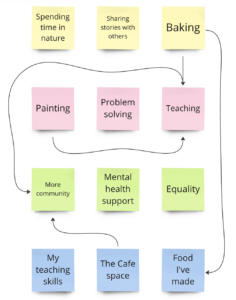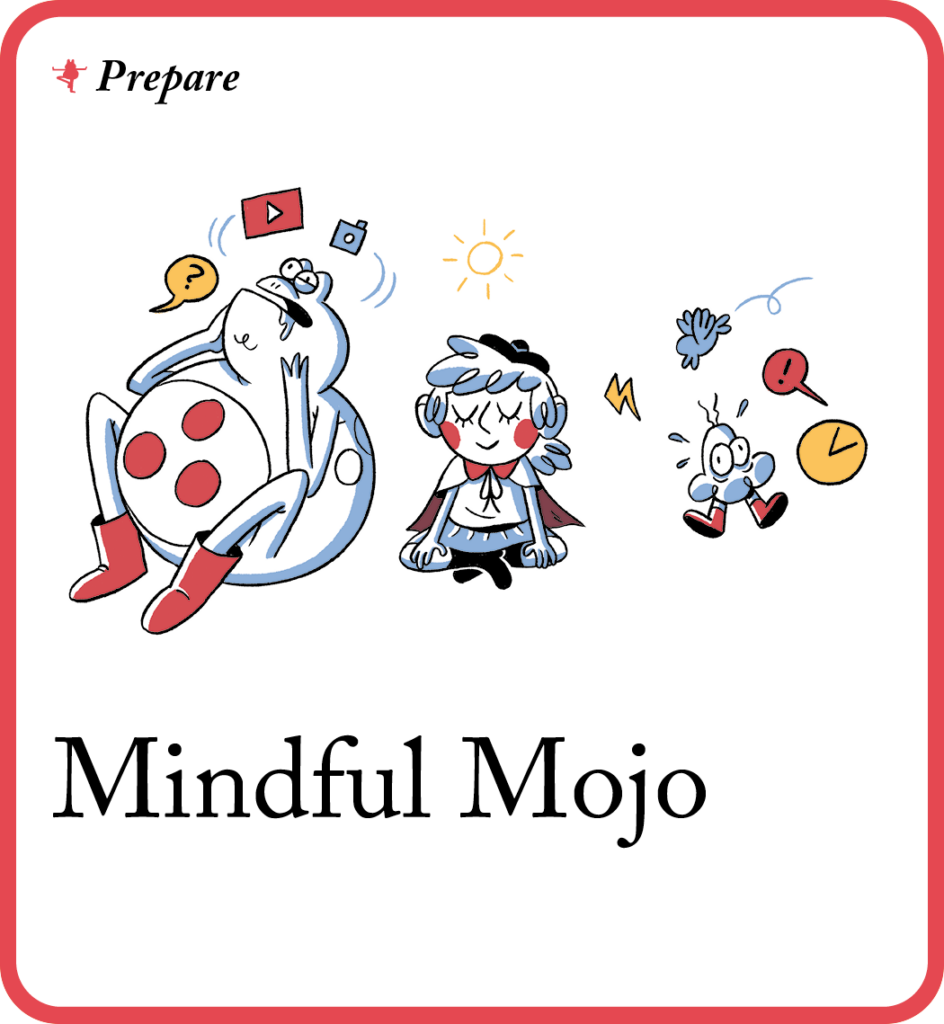Use these tactics
Let’s explore these tactics with an example: Pip’s Cafe
The cafe owners intend to pause, reassess their priorities, and set healthy new habits. See below how Pip’s Cafe uses these tactics to get aligned with what matters.
1
Use Mindful Mojo to practice mindfulness
Use Mindful Mojo to practice mindfulness

👤 Who is needed? Just you
⏱️ How long is needed? 1+ minute(s)
🧠 What’s the goal? Pause…pay attention to the present moment to gain focus, reduce stress and enhance productivity.
👀 Why is this important? Modern life bombards us with distractions, leaving us frazzled and unfocussed. This is a quick and easy technique for centring yourself – perfect before diving into work, after a meeting, or whenever you’re feeling overwhelmed.
💡 Tip: make mindfulness a habit by doing it before or after an activity that’s already part of your routine.
Instructions
-
Find a comfortable and quiet space where you can
sit or stand without distractions. Don’t worry about being totally zen – just aim for a little peace and quiet.
-
Decide how long you want to practice mindfulness (even just a minute or two will do). Set a timer to keep you on track without having to check the clock.

-
Close your eyes or soften your gaze, and bring your attention to your breath. Don’t try to change it – just observe the sensation of inhaling and exhaling.
-
Your mind will likely wander – that’s totally normal. When it does, gently acknowledge it and bring your focus back to your breath. Keep doing this until your timer goes off.
⬇️ Now that you have taken time to focus on your breath and create a gap between everything you were distracted by before, now find your true purpose with the next tactic: Ikigai.
2
Use Ikigai to uncover your true purpose
Use Ikigai to uncover your true purpose

👤 Who is needed? Just you
⏱️ How long is needed? 1+ hours
🧠 What’s the goal? Uncover your Ikigai to align your life and work with your true passions and purpose.
👀 Why is this important? Ikigai, an ancient Japanese concept, is the intersection of what you love, what you’re good at, what the world needs, and what you can be paid for. Use this tactic when you’re seeking direction or motivation, or reassessing your life’s path.
💡 Tip: “The happiest people are not the ones who achieve the most. They are the ones who spend more time than others in a state of flow.” – Hector Garcia Puigcerver
Instructions
-
Set aside at least an hour for deep reflection, free from distractions.
-
Ask yourself probing questions to explore the four key elements of Ikigai. Note down your answers in each section (it’s okay to give the same answer in more than one place):
What do I love doing?

What am I good at?
What does the world need?
What can I be paid for?
-
Look for intersections between the elements. For example, how do your passions and skills connect? How could your skills help people? Which of your skills are most valuable in the market?

-
Write ‘My Ikigai’ on a piece of paper and explore ways you could combine answers from all four sections – things you love, things you’re good at, things the world needs, and things you can be paid for. Welcome ideas beyond your comfort zone.

-
What you do next is up to you. It’s probably a good idea to sleep on it before making any drastic life changes, but beware of the creeping pull of ‘business as usual’.
⬇️ In the next tactic, use the ideas you generated here to design a habit that will help you reach a meaningful goal with Communication Canvas.
3
Use Seinfeld System to start a new habit
Use Seinfeld System to start a new habit

👤 Who is needed? Just you
🧠 What’s the goal? Commit to a key daily action and build an unbreakable streak to achieve great things.
👀 Why is this important? Without consistent habits, we can lose our way. But ‘little and often’ is powerful. Use this tactic as the thread that connects each day to the next.
“After a few days you’ll have a chain. Just keep at it and the chain will grow longer every day. You’ll like seeing that chain, especially when you get a few weeks under your belt. Your only job is to not break the chain.” – Jerry Seinfeld
💡 Tip: the aim is to maintain an unbroken chain, but don’t be too hard on yourself if you skip a day. Just be sure to get back on track as soon as you can.
Instructions
- If you already have a key daily habit that moves you closer to an important achievement or helps you become the person you want to be, jump to step 4.
- If you’re looking to develop a new productive habit, first decide what outcome you’re aiming for.
For example, Set up a community painting class. - Write your goal in the middle of a piece of paper and brainstorm daily habits that could help you. Pick one that feels valuable, and like something you can realistically do every day.

- Get a calendar notebook, or habit-tracking app and visually mark each day you complete the habit.
- Consider picking a specific time to complete your habit each day, and scheduling it. Anchor your habit to an existing part of your routine – for example, immediately after lunch – to help you keep your chain unbroken.

- When scheduling new tasks or accepting new invitations, always consider whether this will cause you to break your chain. Be flexible when you need to – if you have a commitment that clashes with your usual slot, find another time to do it. Commit to keeping your chain unbroken.
Tip: if you miss more than one day, consider breaking the habit down into smaller, more manageable chunks, or finding a more convenient time of day to complete it.
⭐️ Now that you have finished all the tactics, why not repeat the Seinfeld System for another habit relating to your newly found Ikigai? But don’t overwhelm yourself – tiny, successful habits compound over time to make a big impact.
What ways can I use this recipe?
- The complete loop: this means short, separate sessions the second and third tactics. Start both sessions with the first tactic, Mindful Mojo, to help you focus.
- Full-day experience: do it all in one go! Spend the day diving deep and use all three tactics, with lots of breaks in-between.
Some tips
- Practise daily mindfulness and relaxation techniques. Incorporate mindfulness practices such as deep breathing, meditation, or gentle physical exercises like yoga to calm your mind, reduce stress and enhance your ability to handle overwhelming situations with a clearer perspective.
- Seek support and delegate. Don’t hesitate to reach out to friends, family or colleagues for support, and delegate tasks when possible to lighten your workload, ensuring you also set aside time for adequate rest and activities that bring you joy.
What next?
Congratulations! You have completed a round of How to maximise life’s 4,000 weeks ! You have discovered a moment of calm, your Ikigai and a new habit to help you achieve a meaningful goal.





I have 4000 weeks, wow. Okay, this is going to be a great recipe for me to use. Thanks for the structuredd resources.